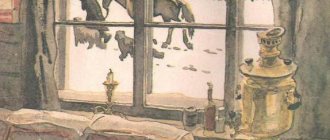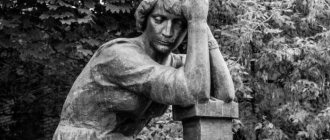The prose presented to the reader is especially poetic, the poems are full of simplicity and brevity. A striking example of a worthy creation is the work “Loneliness”.
The plot of the poem tells about the lyrical hero, who is very worried after parting with his loved one. There are no particularly sublime phrases in the work, and the plot is based on ironic sadness. It is about the past love that led to separation that the work “Loneliness” tells. To experience an extraordinary poetic intent. You will need to carefully analyze the work.
Loneliness
And the wind, and the rain, and the darkness Above the cold desert of water. Here life died until spring, Gardens were empty until spring. I'm alone at the dacha. It’s dark for me behind the easel, and it’s blowing through the window.
Yesterday you were with me, But you are already sad with me. In the evening of a stormy day, you began to seem like a wife to me... Well, goodbye! Somehow until spring I will live alone - without a wife...
Today the same clouds continue endlessly, ridge after ridge. Your footprint in the rain near the porch blurred and filled with water. And it hurts me to look alone into the late afternoon gray darkness.
I wanted to shout after him: “Come back, I have become close to you!” But for a woman there is no past: She fell out of love and became a stranger to her. Well! I’ll light the fireplace, I’ll drink... It would be nice to buy a dog.
Brief Analysis
Before reading this analysis, we recommend that you familiarize yourself with the poem Loneliness.
History of creation - the work was written in 1903 in the summer, when the poet was in Constantinople, dedicated to Peter Nilus.
The theme of the poem is the breakdown of relationships and loneliness.
Composition - Monologue of the lyrical hero, this is the form the author chose to reveal the topic, can be divided into three semantic parts: a landscape sketch, a story about the departure of his beloved woman, descriptions of the internal state of the lyrical hero experiencing a spiritual drama.
Genre – elegy with elements of a message.
The poetic meter is a three-foot anapaest, the rhyme is parallel AABB and cross ABAB.
Metaphors - “desert of water”, “life died before spring”, “the same clouds continue endlessly”.
Epithets – “cold desert”, “rainy day”, “early afternoon gray darkness”.
Loneliness of a Writer
In the poem “Loneliness” by Bunin, love is presented as a certain fleeting happiness.
Such feelings always end sooner or later and lead to separation. But it should be noted that in the work these sensations are tightly intertwined with philosophical reasoning. The author asks himself the question: “What does the soul actually experience at the moment of separation? How to survive such a breakup? These are the problems raised in the work. The poet tried to convey to the reader as closely and openly as possible the sensations that are located inside a person.
The poet’s entire work is filled with thoughts about love. This suggests that Ivan Alekseevich often experienced these emotions himself. Almost all of the writer’s works bring the theme of loneliness to the center stage.
The presence of these emotions in Bunin is easily explained. He lived far from his homeland for a long time. The writer constantly traveled and changed one settlement after another. His place of residence was constantly different and this greatly affected his personal life and worldview.
It should be noted that the poem “Loneliness” was written at a time when the author had not yet gone into exile. The key events in his life were still very far away. But the work, created back in 1903, immediately caused a stir.
After a thorough analysis of the work, it becomes clear that even after reaching 33 years old, the author perfectly understood what the pain of loss was. Although he still had his whole life ahead of him, many of the “rules of the game” were already clear to him.
Loneliness (Bunin Ivan Alekseevich Poems)
The main theme of the poem
The poem talks about the author's love for a woman who left him. And the inner state of a person is shown through nature: the poet’s spiritual emptiness is conveyed through its withering.
Prevailing mood and its changes
Already at the beginning we are imbued with a sad mood:
And the wind, and the rain, and the darkness
Above the cold desert of water.
Here life died until spring,
The gardens were empty until spring.
Next, we see the image of an artist (at the easel...), whom nothing pleases, nothing inspires. In the next stanza we learn the reason for this mood. A rhetorical exclamation (Well, goodbye!) and silence (Somehow until spring! I’ll live alone - without a wife...) are used here. These figures show how difficult it is for the author to let go of the woman he loves. But this person is unusual, like all people of creative professions; he gave her freedom, the right to choose:
Your footprint in the rain by the porch
It blurred and filled with water.
And it hurts me to look alone
Into the late afternoon gray darkness.
But for him, probably, the worst thing is not that his beloved left, but that he was left alone. But the author understands that the past cannot be returned, and there is no future, because love has passed:
I wanted to shout after:
“Come back, I have become close to you!”
But for a woman there is no past:
She fell out of love and became a stranger to her.
Although parting only brings him suffering, he knows that life goes on and he needs to move on:
Well! I’ll light the fireplace and drink...
It would be nice to buy a dog.
The last line of the poem disperses the “clouds” somewhat, and the sun begins to peek through them.
Emotions evoked while reading
Of course, loneliness is relative; you can be lonely even in a crowd.
In my opinion, if you find your soul mate, be it a friend or a loved one, you will never be lonely.
Complete the analysis of the poem Dear user!
If you have any information on the analysis of the poem “Loneliness”, please share it with others.
The history of writing the work “Loneliness”
Initially, it should be noted that the poem presented to the reader is dedicated to a person close to the author - the artist-painter Peter Nilus.
Bunin notes that this figure also at one time experienced similar sensations that are described in the work. Already the first lines of the verse explain that the person described in the work is a creative and abandoned person. The author of the work himself, Ivan Bunin, appears in the same image. The author describes himself as a talented and lonely artist who conveys his paintings in the form of words. Dedicating the work to his friend, he tried to convey as fully as possible the poetry of the poem, in which he placed his feelings and experiences.
At that moment in life when Ivan Alekseevich wrote his work, the author was still married. It should be noted that these ties did not last long, although the divorce was not finalized very soon. Bunin's bride did not love or appreciate him, but preferred to visit various entertainment establishments and specially organized evenings. She did not understand the poet himself and did not share his interests with him. She was not interested in what her husband wrote and about what; she had never read his works. All this gave the writer a feeling of loneliness, and Bunin himself later admitted that he had fallen out of love with his wife.
It should also be noted that the work was created precisely in the summer period of the year, but it described autumn. There are a large number of stylistic techniques present here, and the reader is also presented with special images.
Features of the image of nature in the poem “Loneliness”
In the work, the author pays special attention to autumn.
It is the bad weather and the withering of nature that fully convey the author’s nostalgic mood. The poet would hardly have been able to create a mood of sadness and special sadness if he had described, for example, the singing of cheerful birds, or a rainbow-colored landscape saturated with the sun. Despite the fact that the work was written on a warm summer day, the author’s internal state was very sad. This is reflected in the sad story. For every poet and writer of that time, landscape and natural nature were the main artistic images that were able to convey as accurately as possible the situation that surrounded the main lyrical character at that time. Nature has always helped writers convey their internal state as accurately as possible.
Particular attention must be paid to the first stanzas. Here the poet describes the space around him. This is rain, and darkness, and constant cold. Such images immediately convey to the reader the characteristics of a mood filled with sadness and sadness. The entire created picture, presented in the form of a dull landscape, tells the reader that life has come to a standstill. The author also notes that this will not always continue and sooner or later spring will come on the path of life.
Features of the lyrical hero in the work “Loneliness”
You can understand how frank the hero’s image is in front of the reader immediately after the initial description of the outside situation.
The author does not pay much attention to the personality represented in the creation, and presents his description in a brief form. It is worth noting that it immediately becomes clear that this person is an artist-painter. Bunin's work “Loneliness” is something between a special confession and a monologue about the path of life. The author says that man belongs to the world of sorrow and sadness.
For many centuries, among poets and writers, the image of an artist has been a symbol of a certain sadness, as well as an unfulfilled dream. After all, a true painter constantly strives to create his own world, which sometimes, in fact, does not exist at all. Artists always dream of things that can never come true in real life, and they describe their dreams on canvas. This is exactly what the lyrical hero is, who is presented in the work of Ivan Alekseevich. He constantly suffers from loneliness and is filled with melancholy, but hopes that this state will leave him sooner or later.
History of creation
The poem was written in 1903. Bunin created it while in Constantinople. The text concerned not only the problems of Ivan Alekseevich. He talked about his friend, the artist Peter Nilus . They both suffered from loneliness.
Bunin had problems with his wife. Anna Tsakni did not share the poet’s views, considered him callous and condemned him. The couple lived together for only a year, after which the woman left for Odessa. Bunin had a hard time with the breakup. Peter Nilus also suffered from loneliness.
The experiences prompted the poet to write a poem. It is filled with emotion and shows how difficult a breakup can be .
This topic was raised more than once in Bunin’s work. He received the Nobel Prize, his works were recognized with prestigious awards, but all this could not make the poet happy.
Analysis of the poem “Loneliness”
Most of the lines in the work indicate precisely the loneliness that the author experienced during that period of his life.
It should be noted that the work is written in the form of a three-foot anapest. This style allows you to draw the reader's attention to the artistic talent presented by the author. It is precisely this that is a sign of the mastery of fine literature. The poem describes life moments. Fragments from the history of the poet himself and his tragedy. The writer was able to fully convey the subtle shades of feelings that a person who is alone constantly experiences.
The work shows a lyrical hero who is left alone. All the feelings and experiences of the main character merge with the description of nature, which leaves no chance for a quick fix. The landscape is in complete harmony with the emptiness of the inner state: slush, endless clouds, freezing rain.
Parting turned out to be a heavy burden, from which it is difficult to free oneself in a short time. The main character is tormented by turmoil from loneliness. But humility, and even some kind of indifference, comes to the rescue. There are no more illusions left. We'll have to wait for spring: in nature, in relationships, in life.
Means of expression
I. Bunin's poem is not rich in means of expression, but they help the author to convey the feelings of the lyrical hero and to interpret the theme of loneliness in an original way. The text contains metaphors - “desert of water”, “life died before spring”, “the same clouds go on endlessly” and epithets - “cold desert”, “rainy day”, “gray darkness in the evening”.
Intonation gives expressiveness to the emotions of the lyrical hero. The author uses dangling syntactic constructions and exclamatory sentences. The gloomy mood is also conveyed through alliteration : “r”, “z”, “zh”, “w”: “But for a woman there is no past: she stopped loving - and became a stranger to her.”
Previous
Analysis of poems "To a young poet" analysis of Bryusov's poem according to the plan briefly - theme, history of creation, means of expression
Next
Analysis of the poems “Insomnia. Homer. Tight Sails" analysis of Mandelstam's poem according to plan briefly - genre, idea, images







